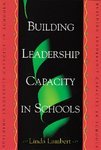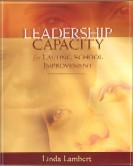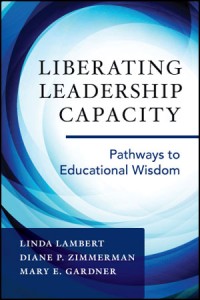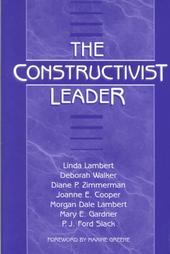Liberating Leadership Capacity
(Teachers College Press)
During the past quarter century, conceptions of leadership have evolved in concert with breakthrough discoveries in science and generative learning. Liberating Leadership Capacity captures these new ideas through the integration of the authors’ earlier works in constructivist leadership and leadership capacity. What emerges is a pathway through which educators can become the primary designers of their own learning and that of their students, thus creating sustainable systems of high leadership capacity. This vision of leadership reframes professional learning designs and knowledge creation, describing how these ideas are richly manifested in local, national, and international programs. The context is democratic communities; the learning is constructivist; the leadership is shared. The result is wise schools, organizations, and societies. Liberating Leadership Capacity speaks to all adult learners who are engaged in educational improvement.
Liberating Leadership Capacity has been released from Teachers College Press in April 2016.
Women’s Ways of Leading
 Women’s Ways of Leading invites the reader into a journey of self-discovery informed by a fresh definition of leadership that transcends position, role and hierarchy and proposes leadership as reciprocal learning in purposeful communities. Lambert and Gardner argue convincingly that this century needs women leaders who commit to values, are conscious of their evolving selves, invoke passion and courage, arouse the imagination, create community and mentor the next generation. Based on the findings of a series of studies examining women leaders across multiple fields of endeavors, the latest findings in brain research and psychology, and case studies from the lives of some of the world’s most remarkable women leaders, Women’s Ways of Leading sets forth provocative possibilities for a world led equally by enlightened women and men.
Women’s Ways of Leading invites the reader into a journey of self-discovery informed by a fresh definition of leadership that transcends position, role and hierarchy and proposes leadership as reciprocal learning in purposeful communities. Lambert and Gardner argue convincingly that this century needs women leaders who commit to values, are conscious of their evolving selves, invoke passion and courage, arouse the imagination, create community and mentor the next generation. Based on the findings of a series of studies examining women leaders across multiple fields of endeavors, the latest findings in brain research and psychology, and case studies from the lives of some of the world’s most remarkable women leaders, Women’s Ways of Leading sets forth provocative possibilities for a world led equally by enlightened women and men.
Lambert and Gardner replicated their studies into women’s leadership in the United States, Canada and Malaysia with women representing careers in education, business, science, arts, government, health and sports. Leadership, the authors find, is constructivist in nature; that is, individuals compose or construct meaning and knowledge based on their own values and experiences. Given this understanding of learning, the question becomes: How do we lead others toward purposeful learning that will change our lives and communities for the better? Women’s Ways of Leading answers this compelling question through an examination of the themes that arose from the study and an evolving framework of perspectives that change with growth and maturity. This framework is formed into an instrument featuring the four perspectives: 1) The Denied Self, 2) The Nascent Self, 3) The Emerging Self, and 4) The Integrated Self. These perspectives were drawn both from our study and from the extensive research on human development. Each theme and perspective leads naturally to a cluster of understandings and skills essential to women leaders. Employing the study’s themes as criteria, the authors suggest “Women to Watch,” leaders who embody the new leadership.
The authors are fully aware that these theme areas can apply to men as well, although women tend to negotiate them differently, informed by distinct values, dispositions, neurobiological wiring and histories. The world they envision asks that enlightened men join forces with the new women leaders to create a desired destiny, the markers for which are defined in the book’s Epilogue.
Click here to see a discussion guide for book clubs reading Women’s Ways of Leading.
The Constructivist Leader
With co-authors Walker, Zimmerman, Cooper, Lambert, M., Gardner, Slack and Szabo
“The Constructivist Leader has taken up where John Dewey left off.”
–Ann Lieberman, Senior Scholar, Carnegie Foundation for the Advancement of Teaching and Visiting Professor, Stanford University
“Linda Lambert and associates take us back to our classroom roots, to what we know best about learning and leading. How exciting it is for me to take those behaviors one step farther and create spaces for all of us in the organization to construct meaning, not only for ourselves but for the community that we are part of.”
–Mary Ann Kahl, Superintendent, Alden-Hebron District 19, Hebron, Illinois
“Lambert and her colleagues continue to break new ground. This second edition deepens the argument for re-framing leadership and provides lots of new examples. If you are looking for a fresh approach, this thoughtful and provocative book is a must. A great book for your leadership team to read.”
–Thomas J. Sergiovanni, Lillian Radford Professor Of Education, Trinity University
Since the publication of the first edition in 1995, The Constructivist Leader has provided educational leaders at all levels with a conceptual framework for leadership defined as reciprocal, purposeful learning in community. Today, learning communities based on constructivist principles are a major part of the school improvement landscape. The Second Edition of this best-selling book enables readers to carry this constructivist vision and purpose forward, while effectively implementing standards-based reform, authentic assessment, and constructivist-based accountability.
The new Second Edition features:
- An expanded theory of Constructivist Leadership based on a thorough examination of the most recent thinking in leadership, learning, and ethical communities.
- A comprehensive approach to issues of equity, diversity, and multiculturalism.
- Additional strategies and approaches for the implementation of constructivist leadership practice.
- Principles and examples to guide new approaches to accountability.
- New school and district stories of successful implementation of constructivist leadership.
- A deeper focus on the district’s role in influencing policy at state and national levels and in protecting schools and classrooms from the negative impact of unwise policies and mandates.
- A new framework for the preparation of educational leaders.
Source: Teachers College Press website.
Who Will Save Our Schools?
With co-authors Kent, Richert, Collay, Dietz
 A compelling new look at the role that teachers must play in the future of schooling. Explains:
A compelling new look at the role that teachers must play in the future of schooling. Explains:
- Why teachers must take the lead in creating a new context for teaching and learning
- How “constructivist leaders” make meaning of learning
- What an ecological perspective will do to initiate and sustain learning communities in schools
- How the parallel roles of leadership with adults and leadership with children emerge in the role of a teacher leader
- The commitments, knowledge, and skills that are essential for teachers as leaders For everyone with a stake in the future of our educational system.
Source: Corwin website.
Building Leadership Capacity in Schools
 Author Linda Lambert takes a close look at leadership in schools, which today involves far more than a single leader. Lambert defines leadership as the learning processes among participants in a community–processes that lead toward a shared sense of purpose.
Author Linda Lambert takes a close look at leadership in schools, which today involves far more than a single leader. Lambert defines leadership as the learning processes among participants in a community–processes that lead toward a shared sense of purpose.
Leadership capacity refers to the breadth of participation in leadership and the depth of skill that teachers, administrators, parents, students, and community members bring to the work. The stories of three schools–an elementary school with low leadership capacity, a middle school with moderate leadership capacity, and a high school with high leadership capacity–reveal how educators can lead their communities to improve student learning.
The stories show five features of effective leadership: broad-based, skillful participation in the work of leadership; inquiry-based use of information to inform decisions and practice; roles and responsibilities that reflect broad involvement and collaboration; reflective practice/innovation as a norm; and high student achievement.
This book outlines what schools and districts must do to build leadership capacity, including how to get started, how to sustain the momentum, and how to design school districts capable of supporting such work.
Source: ASCD website.
 Leadership Capacity for Lasting School Improvement
Leadership Capacity for Lasting School Improvement
Leadership Capacity for Lasting School Improvement is an extraordinary and defining book that provides a blueprint for what is truly possible in continuous school improvement. Linda Lambert expands on her previous work in examining leadership capacity by focusing on an organizational approach that reflects the importance of engaging all constituent voices in the process of reciprocal professional learning. It is a vision of leadership that embraces key assumptions:
- Everyone has the right, responsibility, and capability to lead
- Adult learning in schools and districts is the critical factor in evoking acts of leadership
- Within the adult learning environment, opportunities for skillful participation top the list of priorities
- The manner in which we define leadership frames how people participate in it
- Educators want to be purposeful professionals, and leadership is an essential aspect of professional life
- Educators are purposeful, and leadership defines that purpose
Thus, it is the purpose of schools and districts to create learning environments that reflect these assumptions. Linda clearly recognizes that there is no magic formula that leads to success. It is a process that schools and school districts must collectively embrace. She illustrates the continuum of evolvement with a her Leadership Capacity Matrix where the goal is to develop a high degree of skill and a high degree of participation in the work of leadership, becoming a quadrant 4 school, where sustainable program improvement is the norm. Thru each chapter she provides specific examples to highlight the essential elements that exist in such schools and districts, as well as tools to assist schools on their journey.
Leadership Capacity for Lasting School Improvement is an essential and straightforward book that should be embraced by anyone with a vested interest in seeing schools improve, resulting in our students becoming life-long, self-sustaining learners. We can no longer allow ourselves to be guided by a desire for superficial quick fix approaches. It is time that we engaged ourselves in a purposeful and broad-based effort and this book puts us on that path.
Summary and Review by Bill Bragg (see details on Bill’s career and contact information under Referrals)





 Conceptions of leadership have evolved, and Liberating Leadership Capacity captures these new ideas and provides a pathway to create sustainable systems of high leadership capacity. Available April 2016 from
Conceptions of leadership have evolved, and Liberating Leadership Capacity captures these new ideas and provides a pathway to create sustainable systems of high leadership capacity. Available April 2016 from  A sizzling new novel set in Taos, New Mexico. The third in the Justine Trilogy, preceded by the award-winning, The Cairo Codex and The Italian Letters. Buy it at your local independent bookstore,
A sizzling new novel set in Taos, New Mexico. The third in the Justine Trilogy, preceded by the award-winning, The Cairo Codex and The Italian Letters. Buy it at your local independent bookstore, 


